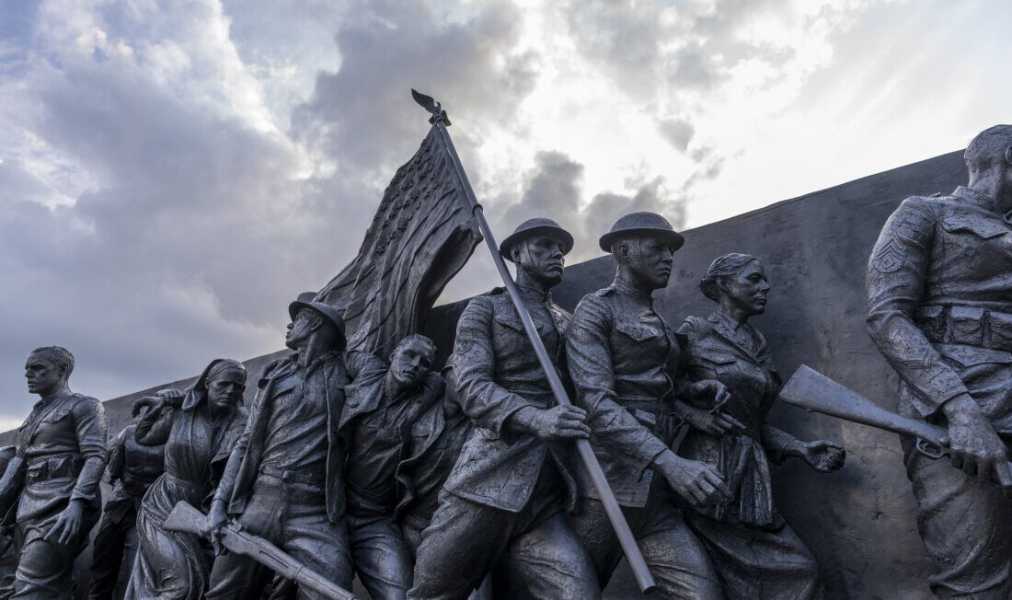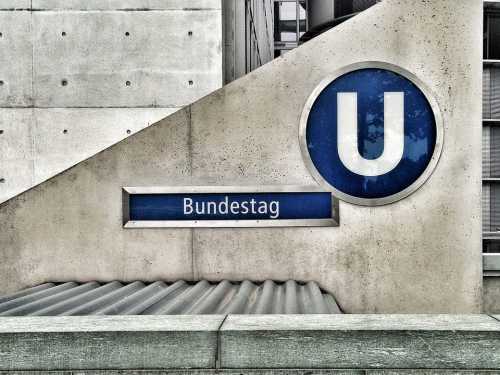A new monument to the First World War is a worthy addition to the best of Washington’s memorials.

Joe Biden has a new neighbor. Pennsylvania Avenue’s latest attraction is a 58-foot-long anti-war monument. A Soldier’s Journey, a frieze composed of 38 larger-than-life realistic figures, tells the story of one American “doughboy” from enlistment to return. A decade in the making by Sabin Howard, this bronze Iliad is epic in scale, operatic in tone and beautifully executed.
Notwithstanding these qualities, discovering an indictment of war’s folly here is surprising. A U.S. president may be black or white, Catholic or Quaker, peanut farmer or real estate mogul, but never a pacifist. That A Soldier’s Journey finds itself next door to the commander-in-chiefbetrays the First World War’s ambivalent place in Western consciousness.
Perhaps monuments always reflect the time they are made as much as the thing they honor. Washington, DC, where the National Mall is lined with what Ronald Reagan called “shrines to the giants on whose shoulders we stand,” is the place to test that theory.
The Washington Monument, the 555-foot granite needle that appears at least once in every political thriller, looms over “America’s Back Yard.” It stands proxy for a country united by the high ideals of its greatest Founding Father, George Washington. But that serene symbolism has complications aplenty. The obelisk went up in 1848, when that unity was still inchoate. There was something ingenious in capturing the nation’s internal conflict in a shrine to a plantation owner who manumitted his slaves at death.
Having weathered its great crises, the U.S. expanded West to dominate the continent and its surrounding oceans. By century’s end, the now rich country was ready to directly broach the Civil War. In 1901, the year an assassin’s bullet made Theodore Roosevelt president, Congress set aside funding to begin the splendidly solemn memorial to Ulysses S. Grant in front of the Capitol.
If Grant was the first modern general, Teddy was the first modern president—an unabashed imperialist who saw as opportunities the “foreign entanglements” that George Washington dreaded. So rote are politicians’ condemnations of war today that Roosevelt’s full-blooded militarism is both shocking and refreshingly frank. “Peace,” he scoffed, “is a goddess only when she comes with a sword girt on thigh.”
When the Great War finally began in 1914, Roosevelt supported Wilsonian ambitions to join the Allies. Roosevelt believed taking part was imperative for the putative superpower. He chastised congressmen who voted against conscription in 1917. One of 50,000 Americans who died fighting in Europe was a young pilot named Quentin Roosevelt. After the Spanish Flu, the national death toll exceeded 100,000.
In 1919, as the vindictive Treaty of Versailles was forced on Germany, Roosevelt died a broken man. Western Civilization never recovered either. That collapse is brilliantly visualized in Howard’s sculpture. The frieze’s center depicts the “crowded hour” where Mars runs riot. The frenzy is terrible and thrilling in a way the younger rough-riding Roosevelt would have relished. The central figure is an officer rousing his men like the famous marine who cried, “Come on, you sons of bitches, do you want to live forever?”
In the aftermath, Howard undercuts our exhilaration by confronting us with the butcher’s bill. A nurse restrains a man blinded by gas as another soldier, clearly shellshocked, breaks the Fourth Wall of the composition. He turns and strides towards us. His foot hovers in empty space stepping out a world of “divine order” as Howard describes it, “into one of alienation.”
America left its innocence in the trenches. While no one could argue that a war of mustard gas, barbed wire and foot rot was glorious, it made J.P. Morgan and DuPont money. These American industrialists and bankers who benefited from British imperial decline would ensure that Uncle Sam got to the party early next time.
While we now associate the interwar years with jazz, cubism, and modernist literature, that cultural disruption took time to take hold—and that is reflected in the monuments of the era. The Lincoln Memorial unveiled in 1922 is solidly classical. Again, we see an America striving to salve raw wounds by harking back to an older and now sanctified conflict. Sculpted by Daniel Chester French with a team of Italian masons, this monumental Abe is not the crafty politician of reality but an immortal patriarch. Indeed, his seated pose and the surrounding temple emulates a lost masterpiece of Phidias, the colossal Statue of Zeus at Olympia.
If the Lincoln Memorial is a church packed with worshipers, the Jefferson Monument is an untended shrine; a reflection, perhaps, of how irrelevant Jeffersonian ideals are to the modern empire. The Roman serenity of Jefferson’s Monument conceals the fact that it was built while another world war, the one that created that empire, raged. The domed building is reminiscent, almost a copy, of Rome’s Pantheon. That architectural quotation may have pleased the Sage of Monticello; the 19ft bronze sculpture inside would not. This graceless lump was cast in 1947, by which time Modernism had its claws in America and academic standards were slipping.
Figurative sculpture may be older than democracy, but to American hipsters of 1950s, that just made it square. Totalitarian associations didn’t help—fascist and communist regimes both embraced the neoclassical pastiche of Heroic Realism—but mainly the problem was that classical symbols were jarringly archaic in an age that prided itself on modernity. What did columns and togas have to do with the age of Atomic Power and Sputnik?
That’s not to say that Modernism produced no great monuments. The Vietnam Wall erected in 1983 is an effective way to commemorate a divisive war. Whether you think that America’s Indochina intervention was a necessary evil or simply evil, Maya Lin’s minimalist design—two long black walls of polished granite engraved with 58,320 names—is oddly eloquent. No commentary, context or justification is offered with the names of the dead—it silently bears witness and lets us draw our conclusions.
But Maya Lin’s memorial derives much of its power from juxtaposition, its functional simplicity contrasting with the iconic Lincoln and Washington monuments at either side of the Mall. The trick can only be pulled off once. Her wall in less august surroundings would be only a wall.
The Korean War Memorial takes a more traditional approach, though it dispenses with plinth and podium. Dedicated in 1995, it is realistic to the point of banality. Nineteen soldiers patrol in the long grass. Clad in raingear, they look stooped, frightened and lost, a forgotten platoon of a forgotten war. Somewhat underwhelming by day, it is most effective at night; their shapeless ponchos make the soldiers resemble a troop of weary phantoms.
No ghosts haunt the World War II Memorial, which George W Bush opened in 2004. It has majesty, if not much imagination. A fountain plays in the center of a plaza surrounded by 56 pillars. The pillars, representing states and territories, are decorated with bronze laurel wreaths. Aside from a pair of decorative eagles and some relief panels, there is none of the elaborate statuary that would have been de rigueur in Theodore or even Franklin Roosevelt’s day. This failure of nerve aside, the memorial is effective. Its chilly grandeur communicates that World War II has become the new cornerstone of the national self-image. That austerity starkly contrasts the pathos of Howard Sabin’s monument. Though World War II killed far more—represented here by stars on the spangled “Freedom Wall”—it remains the Good War fought by the Greatest Generation.
A work of equal dignity to the World War II memorial but far deeper emotion was opened by Barack Obama in 2011. The centerpiece of the Martin Luther King memorial is a non-finito high relief by Chinese sculptor Lei Yixin. It shows a 30-ft tall figure emerging from a granite slab. The composition cleverly communicates that the Reverend’s work is unfinished, just as his crossed arms bespeak impatience. The stern portrait bears comparison to Mount Rushmore’s pantheon. That’s no accident. King now occupies an unassailable position in the national imagination that Theodore Roosevelt, Lincoln, Jefferson and Washington did in 1925.
It is increasingly hard to erect works of such grandeur. The commissioners, curators and critics that governments look to for guidance are indoctrinated in a century-old Modernist critique of academic art that renders them especially incompetent in this sphere. The Commission of Fine Arts, an agency involved in vetting the King memorial, complained of its “colossal scale and Social Realist style”. New York Times critic Edward Rothstein whined, “We don’t even see his feet.” The bizarre MLK memorial unveiled in Boston last year The Embrace is what results when such philistines have their way.
Subscribe Today Get daily emails in your inbox Email Address:
The Eisenhower memorial opened in 2020 was equally misconceived. Designed by Frank Gehry, this much-delayed and ultimately underwhelming edifice proves that Modernist architects simply don’t know how to use statuary effectively. The sculptures of Eisenhower and his staff look stiff and pathetic, dwarfed by featureless monumental blocks. Gehry belongs to a generation of so-called Starchitects, skilled at extracting fortunes from corporations and governments with gimmicky “concepts” and prima donna antics. The Eisenhower memorial officially cost $150 million. Even in the city where they print the money, that’s too much.
The architect Joe Weishaar and Howard took a more honest approach with A Soldier’s Journey. They designed a monument that is revolutionary because it is not revolutionary. It is, rather, a return to form, a return to the exquisitely made and nobly conceived monuments that were the norm in pre-1940 Washington DC.
A Soldier’s Journey will inspire tomorrow’s artists and architects but it would be naïve to imagine that its antiwar message will influence politicians. The princes, presidents, and prime ministers who laid wreaths in Normandy this year and vowed “Never Again” have allowed the Ukraine War to escalate to the point that we are one stray shell away from another conflagration. From history we learn little; still less from art. Even so, whoever is president next year, I like to imagine them taking a break from the next crisis and going for a walk in Pershing Park. I imagine them coming upon a vision of the hell that swallowed much of our civilization a century ago. I imagine them then returning to the Situation Room with a newfound appreciation of diplomacy.
Sourse: theamericanconservative.com






